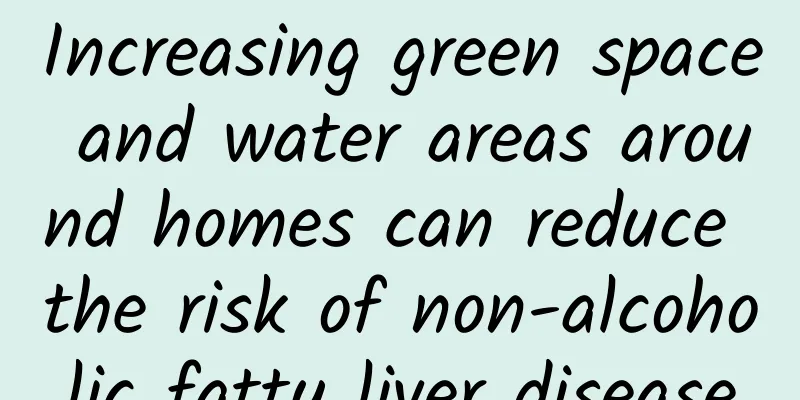Increasing green space and water areas around homes can reduce the risk of non-alcoholic fatty liver disease

|
Green spaces (including parks, grasslands, forests, farmlands, gardens, etc.) and blue spaces (including lakes, rivers, and coasts, etc.) are important components of the human living environment. In recent years, with the acceleration of global urbanization, the rapid economic and social development has also caused serious negative ecological and environmental effects. For example, the loss of green and blue spaces has not only affected the sustainable development of cities and the construction of ecological civilization, but also had adverse effects on public health. Previous evidence has shown that green and blue spaces may reduce the risk of metabolic disorders (such as obesity and hypertension) and related diseases (such as diabetes, hypertension, or metabolic syndrome), all of which may increase the risk of non-alcoholic fatty liver disease (NAFLD). However, no studies have directly evaluated the association between green and blue spaces and the risk of NAFLD. In addition, increasing green and blue spaces is considered one of the strategies to reduce ambient air pollution. Given that exposure to higher concentrations of air pollution is associated with a higher risk of NAFLD, we speculate that air pollution may mediate the effects of green and blue spaces on NAFLD. (Pictures from the Internet, copyright belongs to the original author) In response to this problem, the National Clinical Research Center for Kidney Diseases of Nanfang Hospital, Southern Medical University, has conducted relevant work, and the research results were recently published in the journal Ecotoxicology and Environmental Safety . The study found that the greater the proportion of green and blue space around the residence, the lower the risk of NAFLD; at the same time, the green and blue space around the residence mainly reduces the risk of NAFLD by reducing PM2.5, NO2 and NOx levels. Professor Qin Xianhui of the National Clinical Research Center for Kidney Diseases of Nanfang Hospital, Southern Medical University is the corresponding author of the article, and Dr. Liu Mengyi is the first author. The study included more than 410,000 middle-aged and elderly participants from the UK Biobank study who had no NAFLD at baseline. The average proportion of green space and blue space within 300 meters around their homes was 67.7% and 0.5%, respectively, and the average proportion of green space and blue space within 1000 meters was 70.5% and 0.9%, respectively. After 12.5 years of follow-up, 5,198 participants developed NAFLD. The study showed that: (1) For every 14% increase in the proportion of green space within 300 meters and 1000 meters around a residence, the risk of new NAFLD was significantly reduced by about 12%; for every 1% increase in the proportion of blue space within 300 meters and 1000 meters around a residence, the risk of new NAFLD was significantly reduced by about 5%. (Figure 1) Figure 1 Dose-response relationship between green and blue space around residence and risk of new-onset NAFLD (2) Further joint analysis showed that within 300 meters and 1000 meters around the residence, regardless of the proportion of blue space, a higher proportion of green space can significantly reduce the risk of new NAFLD by 12%-28%; however, only when the proportion of green space is high, a higher proportion of blue space can significantly reduce the risk of new NAFLD. This suggests that a higher coverage of green and blue space (especially green space) in a larger buffer area around the residence will bring greater benefits. (3) Regardless of whether the participants had a high or low genetic risk for NAFLD, a similar inverse association existed between green and blue spaces around the home and the risk of new-onset NAFLD. (4) Mediation analysis showed that the levels of PM2.5, NO2 and NOx significantly mediated 25%-52% of the association between green space around residence and the risk of new-onset NAFLD, and 5%-35% of the association between blue space around residence and the risk of new-onset NAFLD. Overall, this large-scale prospective study shows for the first time that the greater the proportion of green and blue space around a residence, the lower the risk of NAFLD. These findings highlight the potential protective effect of green and blue space on NAFLD, suggesting that residents should raise their awareness of ecological environmental protection, and urban planners need to consider how to promote greener and more sustainable urban development. Green waters and green mountains are as valuable as gold and silver, and they are also health and peace. References: Liu M, Yang S, Ye Z, Zhang Y, He P, Zhou C, Zhang Y, Qin X. Residential green and blue spaces with nonalcoholic fatty liver disease incidence: Mediating effect of air pollutants. Ecotoxicol Environ Saf. 2023; 264:115436. doi: 10.1016/j.ecoenv.2023.115436. Editor | Liu Mengyi Gan Xiaoqin Audit | Qin Xianhui |
Recommend
Can I eat leeks when I have my period?
During menstruation, many female friends will tem...
The pregnancy test paper is not clear and my stomach hurts vaguely. What's going on?
As we all know, women will occasionally experienc...
Is it normal for the fetal movement to decrease in late pregnancy?
In life, many pregnant women will find that the a...
Can I scald my feet during confinement?
Many people are accustomed to soaking their feet ...
What does HPV31 high risk positive mean?
On a quiet night, I heard the sound of flowing wa...
Can pregnant women take apple cider vinegar?
Female friends are very cautious about their diet...
How many red dates are suitable to eat every day during pregnancy?
Many pregnant women do not have ideal physical co...
What should women pay attention to when working night shifts
If you work night shifts frequently, it is easy t...
How to improve the thick placenta
The test tube embryos of female friends have a gr...
How effective is plasma therapy? Is it true that plasma can treat COVID-19?
COVID-19 can be treated with plasma. Currently, m...
Postpartum vaginal itching
We all know that a woman who has just given birth...
Do you know the correct breast enhancement method?
Breasts are the focus of women's self-charm. ...
What foods can nourish the liver and kidneys for women?
The kidneys are very critical organs for the huma...
How much do you know about meniscus?
Meniscus is no stranger to people who like sports...
How to clear the fallopian tubes after ectopic pregnancy?
There are many reasons that lead to ectopic pregn...









